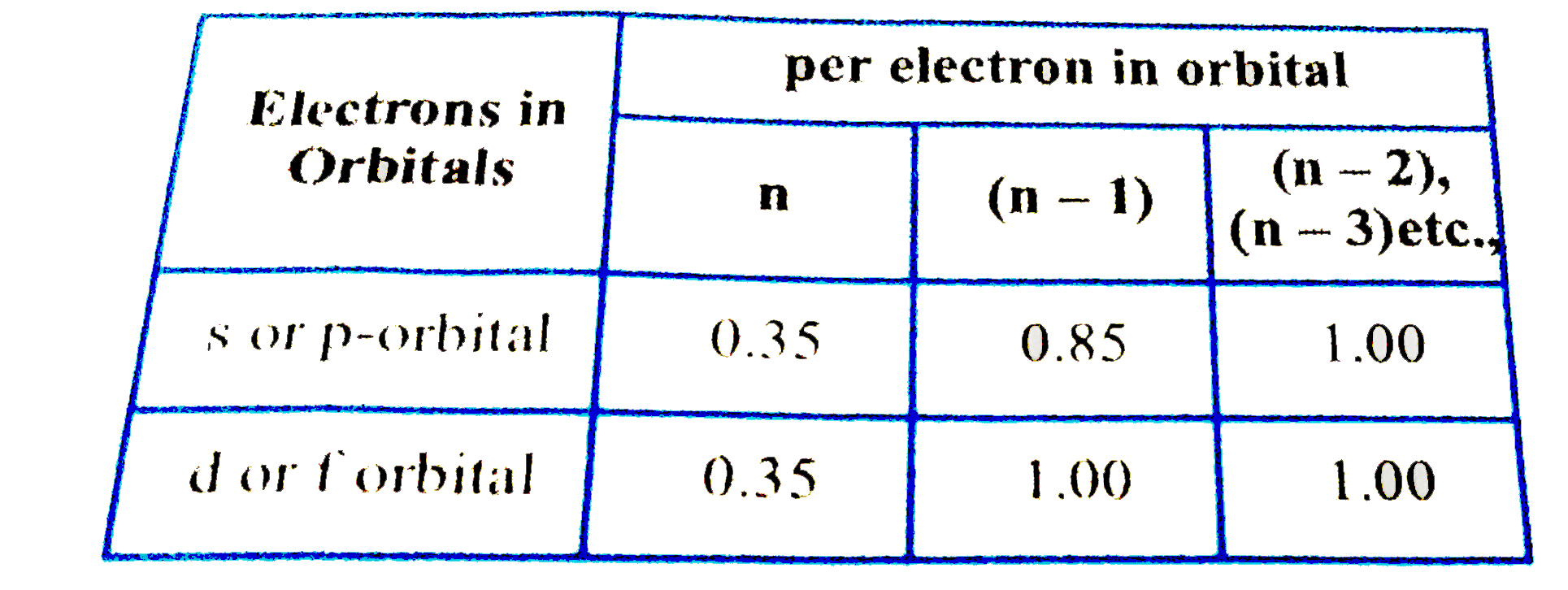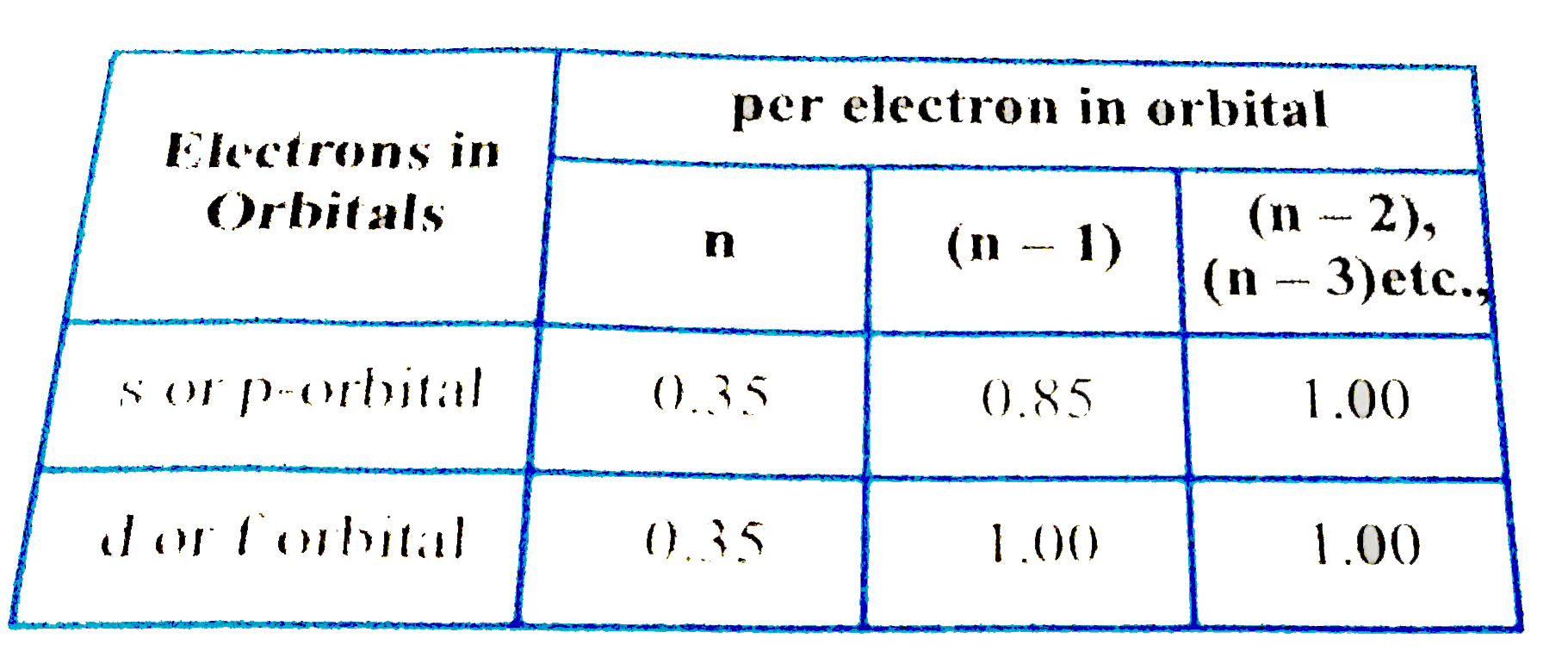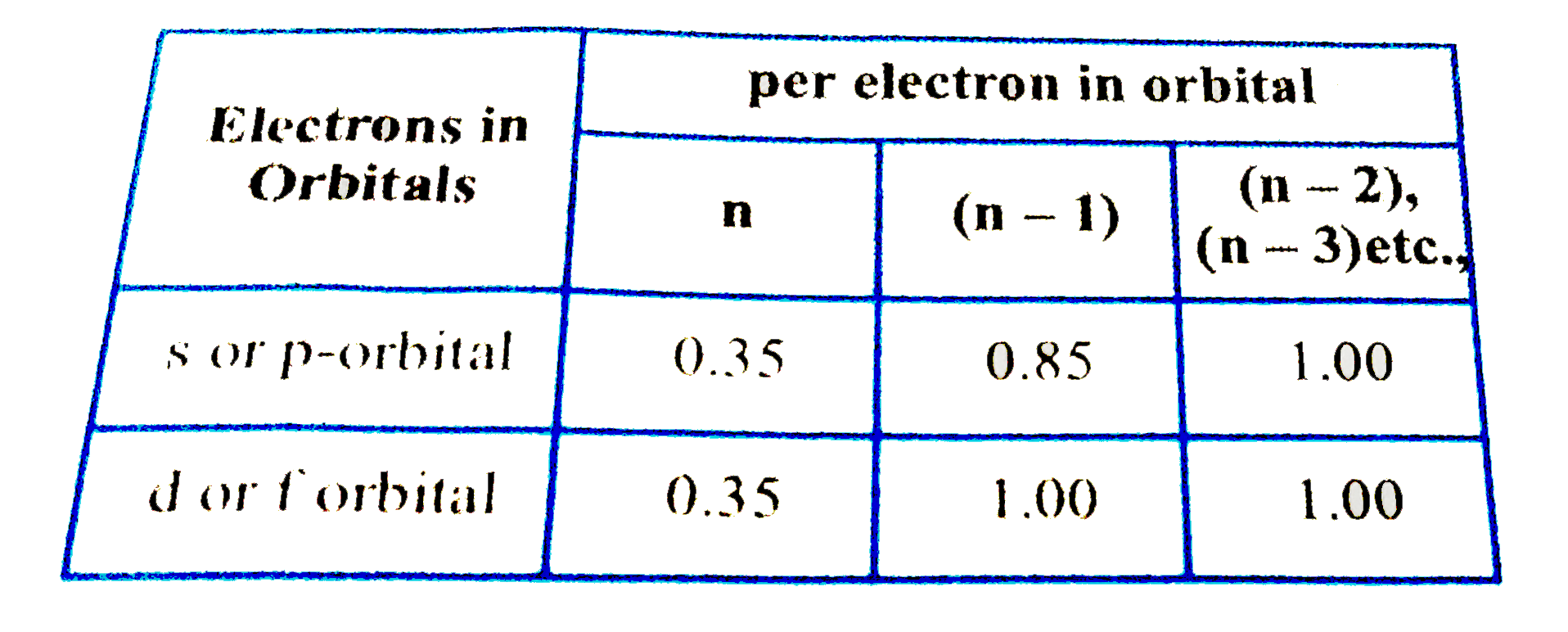Nuclear charge actually experienced by an electron is termed as effective nuclear charge. The effective nuclear charge actuall ydepends on type of shell and orbital in which electron is actually present. The relative extent to which the various orbitals penetrate the electron clouds of other orbitals is
(for the same value of n)
The phenomenon in which penultimate shell electrons act as screen or sheild in between nucleus and valence shell electrons and thereby reducing nuclear charge is known as shielding effect. the penultimate shell electrons repel the valence shell electron to keep them loosely held with nucleus. it is thus evident that more is the shielding effect, lesser is the effective nuclear charge and lesser is the ionization energy.
Q. Which of the following is not concerned to effective nuclear charge?
Higher ionization potential of carbon than boron
Higher ionization potential of magnesium than aluminium
Higher values of successive ionization energy
Higher electronegativity of higher oxidation state
The correct Answer is:B
To determine which of the following options is not concerned with effective nuclear charge, we need to analyze each option in relation to the concept of effective nuclear charge (Z^eff) and its implications on atomic properties such as ionization energy, electronegativity, and oxidation states.
1. Understanding Effective Nuclear Charge (Z^eff):
- Effective nuclear charge is the net positive charge experienced by an electron in a multi-electron atom. It accounts for the shielding effect caused by other electrons.
- The formula for effective nuclear charge can be approximated as:
Zeff=Z−S
where Z is the actual nuclear charge (number of protons) and S is the shielding constant (number of inner electrons).
2. Analyzing the Options:
- Option A: Higher ionization potential of carbon than boron:
- Carbon has a higher ionization potential than boron due to its smaller atomic size and higher effective nuclear charge. This option is concerned with effective nuclear charge.
- Option B: High ionization potential of magnesium and aluminum:
- Magnesium has a stable electron configuration (full s subshell) compared to aluminum (which has an unpaired p electron). The stability of the electron configuration plays a more significant role in determining ionization energy than effective nuclear charge in this case. Thus, this option is less concerned with effective nuclear charge.
- Option C: Higher values of successive ionization energies:
- Successive ionization energies increase due to the increase in effective nuclear charge as electrons are removed. This option is concerned with effective nuclear charge.
- Option D: Higher electronegativity of higher oxidation states:
- Higher oxidation states generally lead to a smaller ionic size and a higher effective nuclear charge, resulting in increased electronegativity. This option is also concerned with effective nuclear charge.
3. Conclusion:
- The option that is not concerned with effective nuclear charge is Option B: High ionization potential of magnesium and aluminum.
Final Answer:
Option B: High ionization potential of magnesium and aluminum is not concerned with effective nuclear charge.
---
- Effective nuclear charge is the net positive charge experienced by an electron in a multi-electron atom. It accounts for the shielding effect caused by other electrons.
- The formula for effective nuclear charge can be approximated as:
Zeff=Z−S
where Z is the actual nuclear charge (number of protons) and S is the shielding constant (number of inner electrons).
- Option A: Higher ionization potential of carbon than boron:
- Carbon has a higher ionization potential than boron due to its smaller atomic size and higher effective nuclear charge. This option is concerned with effective nuclear charge.
- Option B: High ionization potential of magnesium and aluminum:
- Magnesium has a stable electron configuration (full s subshell) compared to aluminum (which has an unpaired p electron). The stability of the electron configuration plays a more significant role in determining ionization energy than effective nuclear charge in this case. Thus, this option is less concerned with effective nuclear charge.
- Option C: Higher values of successive ionization energies:
- Successive ionization energies increase due to the increase in effective nuclear charge as electrons are removed. This option is concerned with effective nuclear charge.
- Option D: Higher electronegativity of higher oxidation states:
- Higher oxidation states generally lead to a smaller ionic size and a higher effective nuclear charge, resulting in increased electronegativity. This option is also concerned with effective nuclear charge.
- The option that is not concerned with effective nuclear charge is Option B: High ionization potential of magnesium and aluminum.
Option B: High ionization potential of magnesium and aluminum is not concerned with effective nuclear charge.
Topper's Solved these Questions
- BOOK - VK JAISWAL ENGLISHCHAPTER - PERIODIC PROPERTIESEXERCISE - ONE OR MORE ANSWERS IN/ARE CORRECT98videos
PERIODIC PROPERTIES
- BOOK - VK JAISWAL ENGLISHCHAPTER - PERIODIC PROPERTIESEXERCISE - MATCHTHE COLUMN11videos
PERIODIC PROPERTIES
- BOOK - VK JAISWAL ENGLISHCHAPTER - PERIODIC PROPERTIESEXERCISE - MATCH THE COLUMN11videos
PERIODIC PROPERTIES
- BOOK - VK JAISWAL ENGLISHCHAPTER - p-BLOCK ELEMENTSEXERCISE - SUBJECTIVE PROBLEMS35videos
p-BLOCK ELEMENTS
- BOOK - VK JAISWAL ENGLISHCHAPTER - QUALITATIVE INORGANIC ANALYSISEXERCISE - SUBJECTIVE PROBLEMS4videos
QUALITATIVE INORGANIC ANALYSIS
Similar Questions
Assign the position of the element having outer electronic configuration,
(A) ns2np2 (n=6)
(B) (n−1)d2ns2 (n=4)
(C) (n−2)f7(n−1)d−1ns2 (n=6)
Which of the following statement(s) is/are correct?06:04View Solution 06:04View Solution
06:04View Solution 01:51View Solution
01:51View SolutionIn phosphorus acid, If X is number of non-bonding electron pairs. Y is number of σ-bonds and Z is number of π-bonds. Then calculate value of "YxZ-X".
01:51View SolutionConsider the following reaction

Then calculate value of ∣∣X2−Y2∣∣ (where X and Y are total number of electrons present t_(2g) and e_(g) orbitals respectively in d-block metal ion of compound B).01:29View SolutionNuclear charge actually experienced by an electron is termed as effective nuclear charge The effective nuclear Z∗ actually depends on type of shell and orbital in which electron is actually present. The relative extent to which the various orbitals penetrate is .s>p>d>f (for the same value of n)
The phenomenon in which penulitmate shell electrons act as screen or shield in between nucleus adn valence shell electrons and there by reducing nuclear charge is known as sheilding effect. The penultimate shell electrons repel the valence shell electron to keep them loosely held with nucleus . It is thus evident that more is the shielding effect, lesser is the effective nuclear charge and lesser is the ionizatio energy.
Which of the following is not concerned to effective nuclear charge?01:56View SolutionNuclear charge actually experienced by an electron is termed as effective nuclear charge The effective nuclear Z∗ actually depends on type of shell and orbital in which electron is actually present. The relative extent to which the various orbitals penetrate is .s>p>d>f (for the same value of n)
The phenomenon in which penulitmate shell electrons act as screen or shield in between nucleus adn valence shell electrons and there by reducing nuclear charge is known as sheilding effect. The penultimate shell electrons repel the valence shell electron to keep them loosely held with nucleus . It is thus evident that more is the shielding effect, lesser is the effective nuclear charge and lesser is the ionizatio energy.
Ionization energy is not influenced by :02:25View SolutionAccording to I.C slater effective nuclear charge, Z∗, due to screening, is not exactly equal to the actual nuclear charge Z of the nucleus of the atom. Z∗ depends on the type of orbitals in which the electron is housed, and on the ability of other electrons in more penetrating orbitals to screen the electron in question from the nucleus.
The relative extent to which the various orbitals penetrate the electron clouds of other orbitals is s>p>f . The effective nuclear charge Z∗ due to screening is given by Z∗=Z−σ, where Z is the atomic atomic number and σ is the slater screening constant values 0<σ<Z

Screening effect of one electron in the outermost orbitals, is not considered in calculate of σ.
What is the value of Z∗ for Rb(37) ?06:26View SolutionAccording to I.C slater effective nuclear charge, Z∗, due to screening, is not exactly equal to the actual nuclear charge Z of the nucleus of the atom. Z∗ depends on the type of orbitals in which the electron is housed, and on the ability of other electrons in more penetrating orbitals to screen the electron in question from the nucleus.
The relative extent to which the various orbitals penetrate the electron clouds of other orbitals is s>p>f . The effective nuclear charge Z∗ due to screening is given by Z∗=Z−σ, where Z is the atomic atomic number and σ is the slater screening constant values 0<σ<Z

Screening effect of one electron in the outermost orbitals, is not considered in calculate of σ.
what is Z∗ for Cu(29) ?03:07View SolutionNuclear charge actually experienced by an electron is termed as effective nuclear charge The effective nuclear Z^(**) actually depends on type of shell and orbital in which electron is actually present. The relative extent to which the various orbitals penetrate is . s gt p gt d gt f (for the same value of n) The phenomenon in which penulitmate shell electrons act as screen or shield in between nucleus adn valence shell electrons and there by reducing nuclear charge is known as sheilding effect. The penultimate shell electrons repel the valence shell electron to keep them loosely held with nucleus . It is thus evident that more is the shielding effect, lesser is the effective nuclear charge and lesser is the ionizatio energy. In which of the following valence electron experience maximum effective nuclear charge?
View SolutionAccording to I.C slater effective nuclear charge, Z^(**) , due to screening, is not exactly equal to the actual nuclear charge Z of the nucleus of the atom. Z^(**) depends on the type of orbitals in which the electron is housed, and on the ability of other electrons in more penetrating orbitals to screen the electron in question from the nucleus. The relative extent to which the various orbitals penetrate the electron clouds of other orbitals is s gt p gt f . The effective nuclear charge Z^(**) due to screening is given by Z^(**)=Z-sigma , where Z is the atomic atomic number and sigma is the slater screening constant values 0 lt sigma lt Z Screening effect of one electron in the outermost orbitals, is not considered in calculate of sigma . What is the value of Z^(**) for Rb(37) ?
View SolutionAccording to I.C slater effective nuclear charge, Z∗, due to screening, is not exactly equal to the actual nuclear charge Z of the nucleus of the atom. Z∗ depends on the type of orbitals in which the electron is housed, and on the ability of other electrons in more penetrating orbitals to screen the electron in question from the nucleus.
The relative extent to which the various orbitals penetrate the electron clouds of other orbitals is s>p>f . The effective nuclear charge Z∗ due to screening is given by Z∗=Z−σ, where Z is the atomic atomic number and σ is the slater screening constant values 0<σ<Z

Screening effect of one electron in the outermost orbitals, is not considered in calculate of σ.
In which of the following cases the concept of Z∗ is applicable?View SolutionNuclear charge actually experienced by an electron is termed as effective nuclear charge. The effective nuclear charge Z∗ actuall ydepends on type of shell and orbital in which electron is actually present. The relative extent to which the various orbitals penetrate the electron clouds of other orbitals is
s>p>d>f (for the same value of n)
The phenomenon in which penultimate shell electrons act as screen or sheild in between nucleus and valence shell electrons and thereby reducing nuclear charge is known as shielding effect. the penultimate shell electrons repel the valence shell electron to keep them loosely held with nucleus. it is thus evident that more is the shielding effect, lesser is the effective nuclear charge and lesser is the ionization energy.
Q. Which of the following valence electron experience maximum effective nuclear charge?01:19:56View SolutionNuclear charge actually experienced by an electron is termed as effective nuclear charge. The effective nuclear charge Z∗ actuall ydepends on type of shell and orbital in which electron is actually present. The relative extent to which the various orbitals penetrate the electron clouds of other orbitals is
s>p>d>f (for the same value of n)
The phenomenon in which penultimate shell electrons act as screen or sheild in between nucleus and valence shell electrons and thereby reducing nuclear charge is known as shielding effect. the penultimate shell electrons repel the valence shell electron to keep them loosely held with nucleus. it is thus evident that more is the shielding effect, lesser is the effective nuclear charge and lesser is the ionization energy.
Q. Ionzation enegy is not influenced by:03:20View SolutionNuclear charge actually experienced by an electron is termed as effective nuclear charge. The effective nuclear charge Z^(**) actuall ydepends on type of shell and orbital in which electron is actually present. The relative extent to which the various orbitals penetrate the electron clouds of other orbitals is s gt p gt d gt f (for the same value of n) The phenomenon in which penultimate shell electrons act as screen or sheild in between nucleus and valence shell electrons and thereby reducing nuclear charge is known as shielding effect. the penultimate shell electrons repel the valence shell electron to keep them loosely held with nucleus. it is thus evident that more is the shielding effect, lesser is the effective nuclear charge and lesser is the ionization energy. Q. Which of the following valence electron experience maximum effective nuclear charge?
03:48View SolutionNuclear charge actually experienced by an electron is termed as effective nuclear charge. The effective nuclear charge Z∗ actuall ydepends on type of shell and orbital in which electron is actually present. The relative extent to which the various orbitals penetrate the electron clouds of other orbitals is
s>p>d>f (for the same value of n)
The phenomenon in which penultimate shell electrons act as screen or sheild in between nucleus and valence shell electrons and thereby reducing nuclear charge is known as shielding effect. the penultimate shell electrons repel the valence shell electron to keep them loosely held with nucleus. it is thus evident that more is the shielding effect, lesser is the effective nuclear charge and lesser is the ionization energy.
Q. Which of the following is not concerned to effective nuclear charge?04:33View Solution

